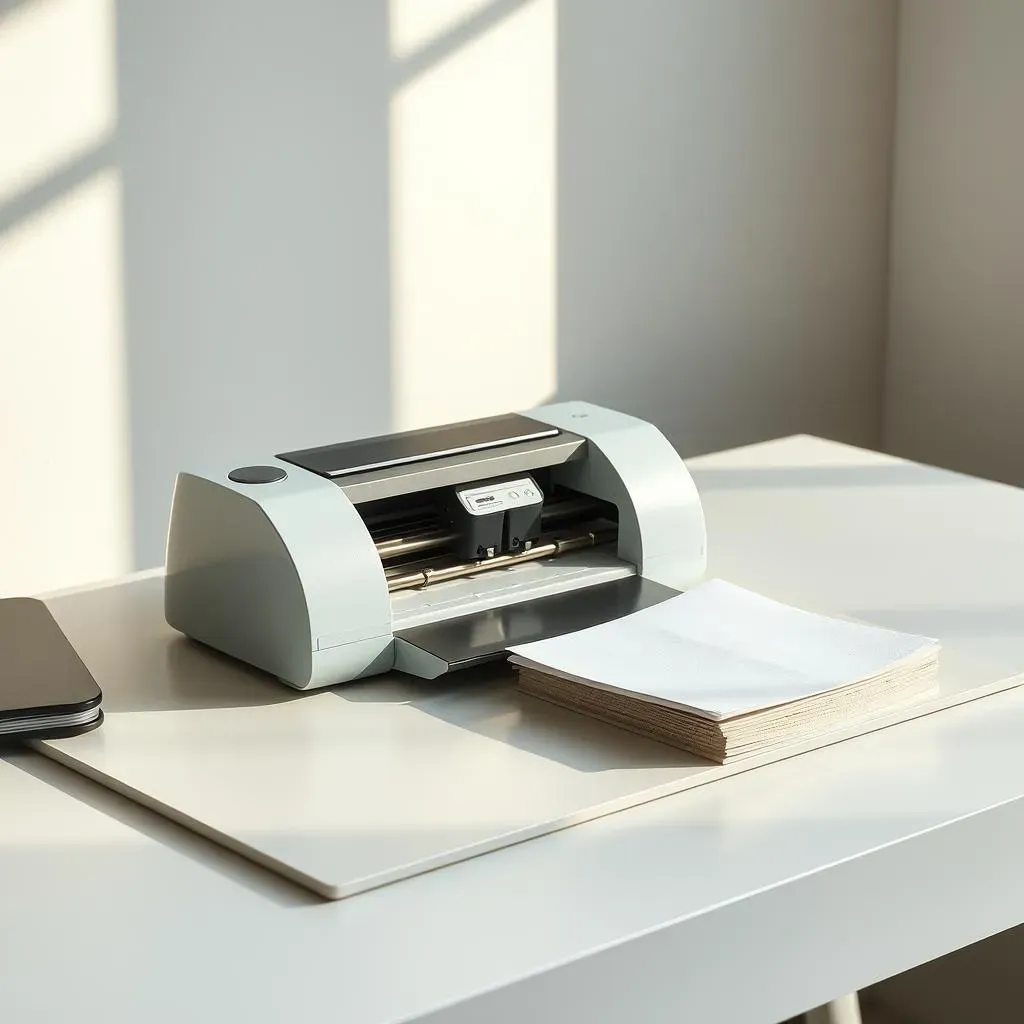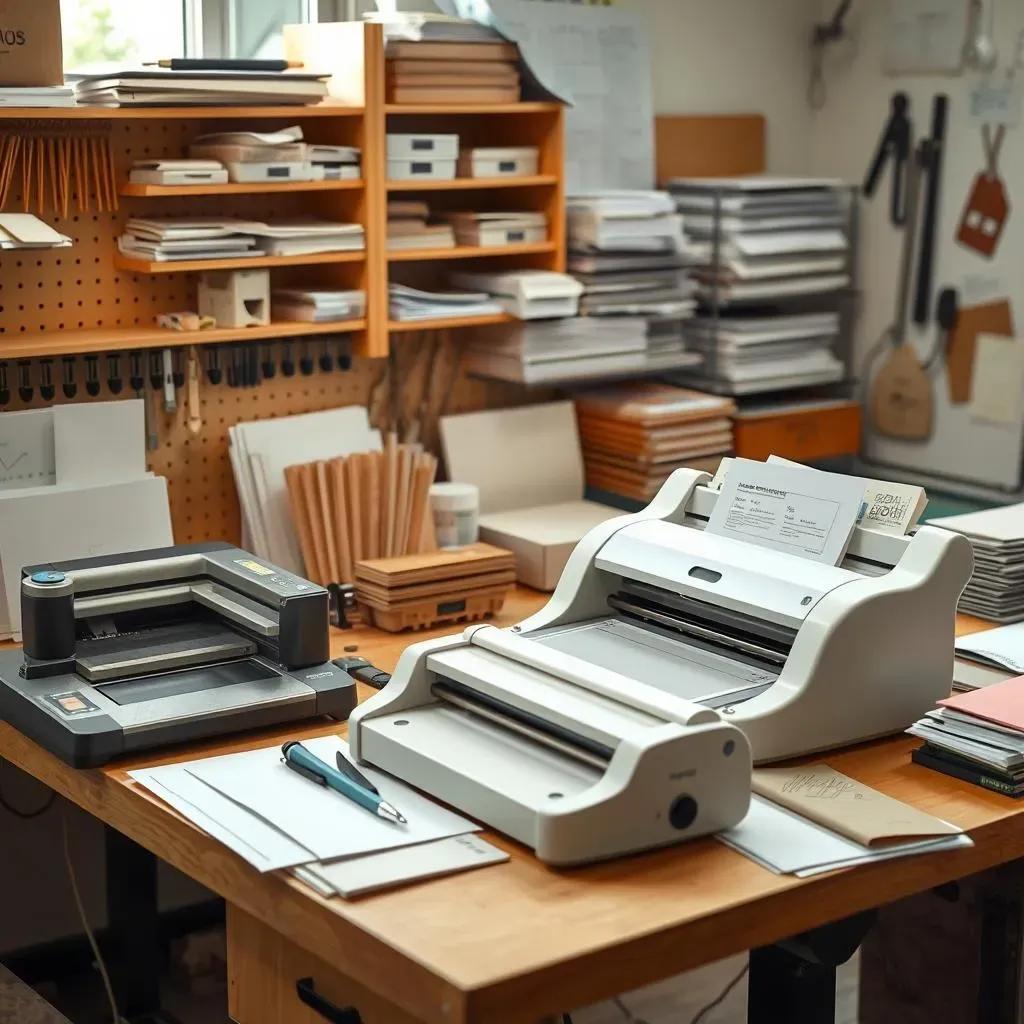Table of Contents
Ever struggled with scissors, trying to get that perfect, clean cut on paper? I know I have! That's where a small paper cutting machine comes in handy. These nifty tools are not just for big print shops; they're perfect for crafters, small businesses, and anyone who needs precise cuts without the hassle. Whether you're making cards, scrapbooking, or creating professional documents, a good paper cutter can seriously up your game. This article will guide you through the world of these machines, helping you figure out what type suits your needs, how to use them safely, and which models are worth considering. We'll explore the different types of small paper cutting machines, looking at everything from manual guillotines to digital wonders. We’ll also cover essential safety tips and tricks to ensure you get the best results. By the end, you’ll be ready to confidently choose and use your very own paper cutting machine, making all your paper projects look sharp and professional.
Why Choose a Small Paper Cutting Machine?
Why Choose a Small Paper Cutting Machine?
so you're probably thinking, "Why do I even need a small paper cutting machine?" I get it. Scissors have been around forever, right? But trust me, once you try a good cutter, you'll see the light. It's not just about being fancy; it’s about precision and saving time. Think about it: ever tried cutting a stack of flyers perfectly even with scissors? Nightmare. A paper cutter gives you clean, straight edges every single time, and it does it much faster. Plus, it’s way safer. No more accidental finger nicks while wrestling with those stubborn blades. For anyone who works with paper regularly, from crafting to running a small business, a cutter isn't a luxury; it’s a total game-changer.
I remember when I first started my little craft side-hustle, I was using scissors for everything, and my projects looked...well, let’s just say "rustic." The edges were uneven, and it took forever. Then, I got a basic paper cutter, and suddenly, my cards and flyers looked professional. The difference was night and day. It’s not just about aesthetics either. When you need to cut accurately, like for invitations or photo prints, a small paper cutting machine ensures everything is just right. It removes all the guesswork and makes the whole process more efficient and less stressful. This is a big plus for anyone working on a tight deadline or just wanting to enjoy their craft time without frustration.
Benefit | Description |
|---|---|
Precision | Achieve straight, clean cuts every time. |
Efficiency | Cut multiple sheets quickly and consistently. |
Safety | Reduce the risk of cuts compared to using scissors. |
Professional Results | Elevate the look of your paper projects. |
Types of Small Paper Cutting Machines: Which is Right for You?
Types of Small Paper Cutting Machines: Which is Right for You?
so you’re sold on the idea of a paper cutter, but now you’re staring at a bunch of different types, right? It’s like walking into an ice cream shop with a million flavors! Don’t worry, I’ll break it down. There are generally three main kinds of small paper cutting machines: rotary trimmers, guillotine cutters, and die-cutting machines. Each one has its own strengths and is better suited for different kinds of projects. Knowing the difference is key to picking the right tool for your needs, so let's take a look at each one individually.
First up, we have the rotary trimmer. These are like the smooth operators of the paper cutting world. They use a circular blade that slides along a track, giving you really clean and precise cuts, making them fantastic for photos, thin card stock, and general paper crafting. They’re super easy to use and pretty safe too, since the blade is usually enclosed in a housing. Then, there's the guillotine cutter, which is more of the heavy-duty option. It has a big, straight blade that comes down with force – think of it like a mini-paper chopper. These are great for thicker materials and cutting through multiple sheets at once, but they do require a bit more caution when using them. Finally, there are die-cutting machines. These are not so much for straight cuts, but for creating shapes and patterns using metal dies. They're perfect for scrapbooking and card making, adding those fancy decorative edges and cutouts.
Type | Best For | Pros | Cons |
|---|---|---|---|
Rotary Trimmer | Photos, thin card stock, general crafting | Precise cuts, easy to use, safe | Not great for thick materials |
Guillotine Cutter | Thick paper, multiple sheets | Powerful, cuts through more at once | Requires more caution, not as precise for small cuts |
Die-Cutting Machine | Shaped cuts, decorative patterns | Versatile, adds unique effects | Not for straight cuts, requires dies |
How to Use a Small Paper Cutting Machine Safely and Effectively
How to Use a Small Paper Cutting Machine Safely and Effectively
Alright, so you’ve got your shiny new paper cutter, and you’re itching to use it. But hold on a sec! Before you start chopping away, let's talk about how to use it safely and effectively. It’s not rocket science, but a few simple steps can make a big difference. First, always make sure your cutter is on a stable, flat surface. You don’t want it wobbling around while you’re trying to make a precise cut. Next, familiarize yourself with the safety features. Most cutters have a blade guard or some kind of lock, so use it! It’s there to protect your fingers. Finally, when you’re actually cutting, don’t rush. Line up your paper carefully and make a smooth, even cut. Rushing can lead to jagged edges and, worse, accidents. It’s all about taking your time and being mindful of the tool.
Now, let’s get into the nitty-gritty of making those perfect cuts. Start by aligning your paper along the guide or ruler on the cutter. This is crucial for getting those straight edges. If your cutter has a clamp, use it to hold the paper in place, especially if you’re cutting multiple sheets. When you’re using a rotary trimmer, make sure the blade is always touching the cutting track, and glide it smoothly from one end to the other. For guillotine cutters, bring the blade down firmly and evenly. Avoid any jerky movements. If you’re using a die-cutting machine, make sure the die is correctly placed and that you apply even pressure when using the handle. It might take a few tries to get it just right, so don’t worry if your first few cuts aren’t perfect. Practice makes perfect, and soon, you'll be a paper-cutting pro!
Tip | Details |
|---|---|
Stable Surface | Always use a flat, stable surface to prevent wobbling. |
Use Safety Features | Engage blade guards and locks when not in use. |
Align Carefully | Line up your paper with the guide for accurate cuts. |
Smooth Cuts | Use even, smooth motions when cutting, no jerking. |
Practice | Don't worry about mistakes; practice to improve your technique. |
Top Small Paper Cutting Machines on the Market Today
Top Small Paper Cutting Machines on the Market Today
so you're probably wondering, "Which paper cutter should I actually buy?" I get it, the market is flooded with options, and it can feel overwhelming. But don't worry, I've done some digging, and I've got a few recommendations for you. When looking at the top small paper cutting machines, it really comes down to what you need it for. If you're just doing light crafting and want something portable, a rotary trimmer is probably your best bet. For heavier tasks, like cutting through stacks of card stock, a guillotine cutter is going to be more your speed. And if you’re into scrapbooking and fancy designs, then a die-cutting machine is the way to go. It's all about matching the right tool to the right job.
Let's start with rotary trimmers. The Fiskars Recycled SureCut Trimmer is a solid choice. It’s affordable, reliable, and has a nice, smooth cutting action. It's great for general use and can handle most paper and thin card stock. If you need something a bit more robust, the Dahle 507 is an excellent option, a bit more expensive, but worth it if you're cutting a lot. When it comes to guillotine cutters, the Swingline ClassicCut Pro is a crowd-pleaser, it can handle a good amount of paper, and it's built to last. For die-cutting machines, the Cricut Explore Air 2 is a popular pick, it's versatile and can cut a wide range of materials, plus, it has a huge following and lots of online resources for inspiration. Another great die-cutting option is the Sizzix Big Shot, it's easy to use, portable, and great for smaller projects. Remember to always double-check the reviews and specs before making your final decision, since everyone has slightly different needs and preferences.
Machine Type | Recommended Model | Best For |
|---|---|---|
Rotary Trimmer | Fiskars Recycled SureCut Trimmer | General crafting, photos, thin paper |
Rotary Trimmer | Dahle 507 | Frequent use, precise cuts |
Guillotine Cutter | Swingline ClassicCut Pro | Thick paper, multiple sheets |
Die-Cutting Machine | Cricut Explore Air 2 | Versatile die-cutting, various materials |
Die-Cutting Machine | Sizzix Big Shot | Portable die-cutting, smaller projects |
Wrapping Up: Your Path to Precise Paper Cuts
So, there you have it – a comprehensive look at the world of small paper cutting machines. We've journeyed from understanding why they're so useful, to exploring various types, and finally, how to use them safely and effectively. Choosing the right machine depends on your specific needs, whether you're a casual crafter or a small business owner. Remember, practice makes perfect, and with the right tool, those frustrating, jagged edges can be a thing of the past. Embrace the precision and efficiency a small paper cutting machine offers, and watch your projects transform from good to great. Now, go forth and create with confidence!